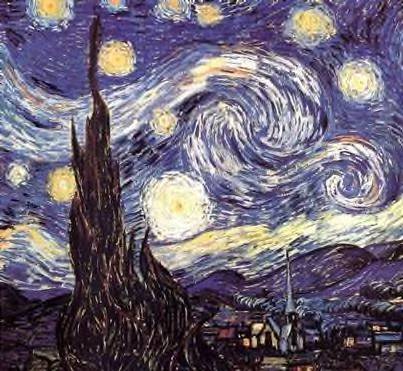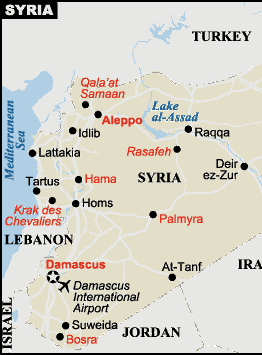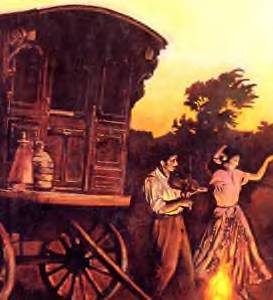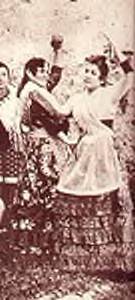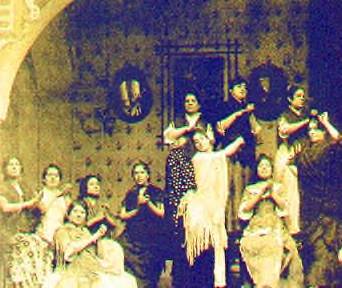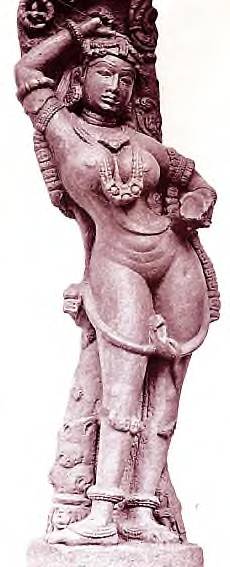|
|
|
|
 |
 |
 |
 |
 |
 |
 |
 |
|
Free Spirit - - An Interview with |
|
|
|
Monique Monet |
|
|
by Alaoui Zagora
Originally published in Zaghareet Magazine |
|
|
|
(The following is a compilation of three interviews conducted in Honolulu, Hawaii, and later by telephone between Kauai, Hawaii and Vancouver, B.C.)
|
|
|
 |
 |
 |
 |
 |
 |
 |
 |
|
Alaoui Zagora: I noticed that you began your film, Revolutionary Dance, with a quote from long ago by an early American
dancer. Why was that? Monique Monet: Because to me it's probably the single greatest guiding truth for all areas of contemporary dance. Isadora Duncan said, "The woman of the future will
be a free spirit, representing the highest intelligence in the freest body." AZ: And you believe her prediction is now at last coming to pass? MM: Yes, I
believe her words, from nearly a hundred years ago, are finally becoming reality now. And I thank God that, maybe even in the smallest of ways, through my film, or an essay or article, I can help with this exciting step
in women's spiritual and physical evolution.
(Isadora Duncan) |
|
|
|
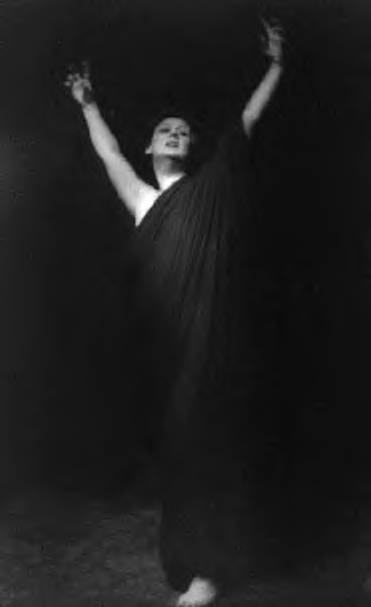 |
|
|
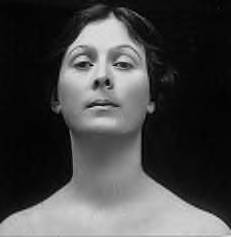 |
|
|
|
|
|
In her writing, Isadora Duncan often used dance as a simile for life,
and vice versa. She predicted a new freedom of self-expression in dance (and life) - - mentally, spiritual, and physically. And it's happening. Not everyone is ready for it yet. But it's kismet
- - fate; true dance must go this way, forward, evolving into greater artistry and personal/spiritual expression. |
|
|
|
 |
 |
 |
 |
 |
 |
 |
|
We've arrived at a time when the true dancer, inspired by cosmic energy, has no choice but to move out of the doldrums of
inhibiting tradition and into the racing current that is living contemporary dance. Dance is a verb, an action word, and never have the times so emphasized this fact as now. This
is the year, the decade, perhaps the century, of the divine innovator. A dance artist has little choice but to go with the flow of the cosmos. AZ: Talking about self-expression
and freedom, let's move from macrocosm to microcosm. From the cosmos of dance, to you personally . |
|
|
|
It's my understanding that you have, long hidden deep in the shadows of your private
life, a unique influence that many might consider a contributing factor in your obviously very passionate concern for freedom. MM: I think I know what your talking about. And I'm
glad you have brought that up. That's a direction that I'd like to go. AZ: Alright. And to use word association as a springboard to this new topic - - when I think of
"freedom" one of the first words that comes to mind is "Gypsy". And I understand this is a topic which is of increasing importance in your life. |
|
|
MM: It is very important to me. And it's something about which, for as long as I can remember, I've had mixed feelings.
Definitely mixed feelings. My mother's family are Gypsy, from the Middle East - - Lebanon and Syria. But this has always been a deep, dark secret. "If anyone asks," my Grandmother used to say,
"tell them you're Lebanese." |
|
|
|
AZ: Let me interrupt our conversation for just a moment to clarify a point. It
seems like within the last few years there have become so many new, more "politically correct" terms to replace the word Gypsy. Rom, Romi, Romani, etc. Which term do you prefer?
MM: I could talk for an hour on the ancient, honorable, and intriguing history of the word, Gypsy. That is my preference - - as long as you spell it with a capital
"G". AZ: Thank-you. And before my rude interruption you were explaining that , during your childhood, your Gypsy heritage had always seemed a negative thing. Why? I
thought "Gypsiness" is popular, kind of trendy, in the world of contemporary Middle Eastern Dance. |
|
|
|
 |
 |
|
AZ: What a sad thought to grow up with. So why are you talking about it now?
MM: Because I'm not a child anymore. Because I know there's nothing to be afraid of. But mostly, and on a more superficial level, because I'm annoyed by all these people who claim to be experts on the Rom, teaching
about Gypsy Dance, Gypsy costuming, Gypsy magic, Gypsy morality - - all these bizarre stereotypes. AZ: Stereotypes? Like what? MM: Oh - - all this stuff I want to
cover pretty soon in another film - - But okay, one small but particularly annoying example: Gypsy Dance. There is no such thing as "Gypsy Dance". AZ: No? Then what's that I see
advertised in every Middle Eastern Dance magazine? MM: A lot of it is archaic East European or Middle Eastern "folk dance", and some of it's just plain fake dance.
AZ: I'm sorry but I don't understand exactly what you are saying; would you clarify for me. MM: Okay. For example: If a Japanese woman in Tokyo told us she was
studying "American Dance", we'd be surprised to see her suddenly doh-se-doh into a Texas square dance or start stomping out an Appalachian clogging routine, right?
AZ: Yes, I guess we would. |
|
|
 |
 |
|
MM: That's right, because what she was really studying was old time, regional, American folk dance. Certainly not
contemporary American dance. It just bothers me that people are teaching regional 18th century Romanian folk dance, or something similar, and claiming that it's contemporary Gypsy dance.
|
|
 |
 |
|
AZ: Okay, I now understand the folk dance part, but what do you mean by fake dance?
MM: Someone in a Gypsy skirt, with a scarf, and a lot of nerve, swirling and stomping - - and calling it "Gypsy Dance". AZ: But wait, the USA is a free
country, I suppose anyone can make up a series of dance moves and call it whatever she wants to. MM: But that doesn't mean it's the real thing. AZ: I see
what you are saying. And even with my somewhat limited experience, I believe I have recognized some of those magazine ads as being less than authentic. But I must admit a question still hangs in my mind.
MM: What is that? AZ: Well, when you tell me there is no such thing as Gypsy dance, I have to wonder, when the music plays, the Gypsies just stand there and do
nothing? |
 |
 |
|
MM: No, of course not. But when the music begins all Gypsies don't just naturally and in
unison break into some kind of skirt-swirling, Flamenco-like choreography. |
|
|
 |
 |
 |
 |
|
AZ: Okay, so I understand what Gypsies don't
do. But I'm now all the more curious to understand how they truly dance. MM: Just like other human beings, different Gypsies express themselves through dance in many different
ways. As much as I would like to be, I don't claim to be a Gypsy scholar. But I have family - - aunts, uncles, cousins, nieces, in Seattle and the Bay Area, who are still part of Romi life. And a lot of
times, when we get together, we dance. And it's, by definition, "Gypsy Dance" simply because we are Gypsies - - dancing. |
|
|
But it's very different from the outdated, very regional (usually Andalusian) style that's often taught as Gypsy Dance. And, of course, it's different from Gypsy
Fusion, which is usually some dance instructor's complete fabrication. |
|
|
|
 |
 |
|
AZ: Okay, so there's no such thing as a universal Gypsy style. And you said the folk and fusion currently
being taught aren't real Gypsy Dance. MM: That's right. AZ: If no one is teaching the real thing, how do real Gypsies learn Gypsy Dance?
MM: From their mothers, their grandmothers - - or maybe from Martha Graham, or from MTV. |
 |
 |
 |
 |
|
 |
 |
 |
 |
|
 |
|
|
|
AZ: You're kidding about MTV? MM: Not at all. Gypsy
women and girls are generally interested in anything that has to do with dance. They go to dance clubs, they watch music videos, and if they happen to see a dance move they like, they don't hesitate to take
it as their own. |
|
|
AZ: Earlier, when you mentioned being bothered by stereotypes and false experts,
you said there was no such thing as Gypsy Dance. I assume you were referring to what is being marketed
as "Gypsy Dance." But really, among the many Romi people, or at least among the Gypsy women in your personal experience, doesn't Gypsy Dance still exist? Aren't there some commonly shared, styles, moves?
|
|
|
|
MM: Oh, yes, often I can see a similar style among a family of dancers. But truly,
it's more an attitude within their dance than a particular series of steps. AZ: Hmm - - our conversation is moving away from what I had anticipated. It seems you are
leading me into the realm of the ethereal. But still I will not let you elude me: You say it's attitude more than dance steps . What do you mean? Some examples, please.
MM: A Gypsy dancer is different from the average American dancer. Of course, I'm talking in broad generalities, but it's the truth. For one thing, the Gypsy dancer is more at ease
with her own sensuality. Although she honors much strict cultural tradition and is highly moral, she possess an attitude of body acceptance and body freedom to a degree that is misunderstood by most
non-Gypsy dancers. AZ: Example? |
|
|
|
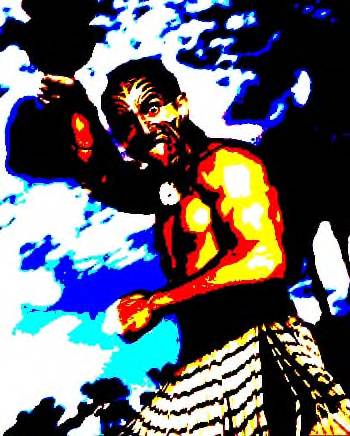 |
|
 |
 |
|
MM: Okay. Imagine you're a tourist at a luau watching the performance of a Hawaiian war
dance. The dancer is making stylized moves of aggressive violence as part of the message of his performance. The aggression is a part of his art. But that doesn't mean he's going to jump down among the
audience and start spearing people. AZ: No pun intended, but I think I missed your point. |
|
 |
 |
|
MM: Okay, I'll try to be more explicit: When your average western dancer sees a mainstream dance
performance that contains even slight nudity, instantly the alarms go off. Sin! Strippers! Prostitutes! Pimps, drugs, and |
 |
 |
|
everything else that leads straight to hell. |
|
|
 |
 |
 |
 |
|
The Gypsy dancer doesn't think that way. Dance is her art and her body is her instrument. And
in rare instances, she is happy to make full artistic use of that instrument in her quest for self-expression. It's just a part of her personal artistic expression, nothing more.
AZ: You mean . . . . MM: Yes, rarely but sometimes, nudity. A wide range of sensuality and sexuality are on her creative palate. Not in a dirty, smirky,
Playboy way. But like the ancient fertility dancers of Sumer, or the dancers depicted in the India temple carvings, the Gypsy dancer owns her own natural and healthy sensuality. |
|
|
|
This is an attitude that we've preserved, deep in our souls, for all those
centuries. And I think it's something more desperately needed today, by all women, than ever before. AZ: Why? What's the emergency? |
|
 |
 |
|
MM: We live in a world ruled by media and owned by business. Constantly, in our commercial mainstream
society, women are psychologically bullied into abandoning their own femininity and self-worth. AZ: Once again, will you provide me with an example? MM: In many
very personal ways the media offers women only a very narrow and tight-fitting role in our modern society. AZ: What do you mean? |
 |
 |
|
MM: Sometimes it seems like we live in a completely commercial society where everything
is for sale, if the price is right. After suffering decades of bullying, too many women have sacrificed all their personal power and self-image on the two-dimensional alter of our Playboy/MTV pop culture. And all too often now, the crass and the sexually retarded are those whom we allow to define our cultural ideals of beauty, sensuality, and the essence of what it means to be feminine.
|
|
|
 |
 |
|
AZ: What does your Gypsy culture offer as an alternative to this manipulative mainstream culture?
MM: What we can offer is our unique and healing perspective. We are like the little child who shouts out the truth in the fable The Emperor's New Clothes. We see from a slightly different
perspective. We know their tricks. And when I say they, I mean all of those in MTV, Hollywood, TV advertising, etc. who make money by manipulating the image of women. AZ: What is it
that gives you this insight that protects you from mass manipulation? MM: Simply because we can see through them, we are immune to their poison. I'm not really sure exactly what it is; but
maybe it's the ancient culture we draw from. Or our naturally aggressive independence from the culture amidst which we live. We do not easily subject ourselves to supposed authority. But whatever it is, I know we see
with our own eyes. And because of that, we have a much wider definition of feminine worth and beauty. |
|
|
 |
 |
|
The air-headed gods of pop culture decree that the Barbie Doll is the epitome of feminine
perfection, and 90% of American women apologize for not measuring up and then grab for the phone book in search of diet plans and silicon breasts. |
|
 |
 |
|
AZ: My job as interviewer is to guide the direction of our conversation. A task at which I am currently
failing. I ask that you excuse this purely benevolent manipulation on my part, but is there a point at which pop culture, corporate America, Gypsy women and mainstream American women all converge on the topic of dance?
MM: That's a point we never left. We've just been exploring its subterranean realms. AZ: Oh, good. My mistake, please continue. MM: As
I was saying, we have no desire to be Barbie Dolls. Nor do we apologize for not being eternally youthful. Gypsy women are not often the victims of someone else's arbitrary opinion, or of the calendar.
We tend to live our lives more in touch with our true feelings rather than how someone tells us were "supposed" to feel at a particular age. Mental attitude is so very important. I
know of several strikingly beautiful Gypsy women over 50 years old. And on the other hand, I know of Gypsy women who seem to have no interest at all in the glamour scene. But in both examples it's they who chose, based
on how they decided to present themselves to the world. I think we are not so frightened of the opinion of others. AZ: Excuse me for being obtuse, but how does all this you're speaking of
influence dance? MM: A very important question. The biggest influence of all is in dance. Many, many times I've heard women actually apologize for the implied faux pas
of continuing to dance even beyond that "certain age". I know a woman in S.F., a very well known and talented dancer, beautiful by anyone's standards, who has retired from dancing
because she and her husband feel it's the proper
thing to do at "her age". She wants to dance, she is at the height of her powers, she has years of priceless training and experience - - but she can't dance because of an arbitrary date on the calendar. She keeps herself in a prison.
I know of another woman who is a prisoner. I danced with her in Honolulu. And she really does look like a dark-skinned Barbie. She's an excellent dancer and in perfect physical condition, but
when the club owner asked her age she told him the truth - - and she was out of the show. She could have claimed an age fifteen years younger and no one would have thought to question it. But she told the truth and he
reacted according to his MTV programming, and she wasn't allowed to dance. Looks and talent counted for nothing because in his mind she was automatically "too old". AZ: If she were
a Gypsy, things would have been different somehow? MM: There is a kind of Gypsy Judo that is very effective when dealing with all levels of mindless bureaucracy. If a Gypsy woman wanted to
dance in that particular dance club and it was necessary for her to be 15 years younger then she was; then she would of been 15 years younger. And the owner's only thought would have been how proud he was to have a
dancer of her caliber performing in his crummy club. I said earlier that we see a wider range of beauty. And when it comes to dance expression our range of appreciation is infinitely more
vast. AZ: She was attractive and physically fit and could get away with fictionalizing her age and telling the club owner what he wanted to hear. I understand all that, but what does that
have to do with "infinitely vast dance"? MM: They're linked by attitude. It's simply another instance of the overwhelming importance of attitude. In most instances, a
Gypsy dancer would never lower herself to perform in a venue where her sister dancers were being accepted or rejected simply because of their birthdate - - or the color of their skin, or hair, or something equally
silly. We've endured too much of that. A slight or insult to one of us is an insult to all. And we don't tolerate it. AZ: I applaud your solidarity; but what of this "more vast"
dance you've spoken of? MM: It is the very soul of Gypsy dance. It is the priceless ability to dance from the inside out. And it's the viewers almost equally valuable
ability of being able to truly see and appreciate such a dance. The single most important factor of Gypsy dance is this inwardness. |
 |
 |
|
Youthfulness, movie-star beauty, even incredible technique, are all secondary to the ability to express
your inner-most being through dance. In my experience among |
 |
 |
|
Gypsy dancers, the most respected and admired performer might be a woman well past middle-age and physically in no way
comparable to a Barbie doll. In a Hollywood movie, or on MTV, such a woman dancing in a serious manner would be seen only as some sort of comic interlude. Not because of anything funny about her actions but
simply because the viewer has been programmed to believe that only the young and stereotypically beautiful have the right to express themselves though dance. This is where our vastly wider range of
appreciation comes in. |
|
|
 |
 |
 |
 |
|
Of course, youth and beauty are nice and we appreciate it too - - for what it's worth. But the
older woman is often the star of our group because she offers so much more. In her performance we might see the expression of decades of confident fulfilled |
|
|
|
sensuality. She might, through her dance, subliminally tell us the true story of passionate love, tragic loss, and the
triumph of love recaptured. Or transcending even that, she might share with us a glimmer of the ancient days when God was a woman and we, created in her image, were the honored emissaries of divine love and the earthly
creators of human life. No matter how wealthy a society might be in material things, if it deprives itself of gifts like these, it is truly a underprivileged society. AZ: Perhaps the Gypsy woman, descendant of an
ancient culture, is the prototype for Isadora Duncan's woman of the future. MM: I wouldn't argue with that. ". . . a free spirit, representing the highest intelligence, in the freest body."
|
 |
 |
|
Alaoui "Al" Zagora is an international journalist who has written for Associated Press, United Press International, Christian Science
Monitor and other world-wide agencies, as well as many international magazines. He currently resides in Vancouver, B.C. |
 |
 |
|
All rights reserved |
|
























